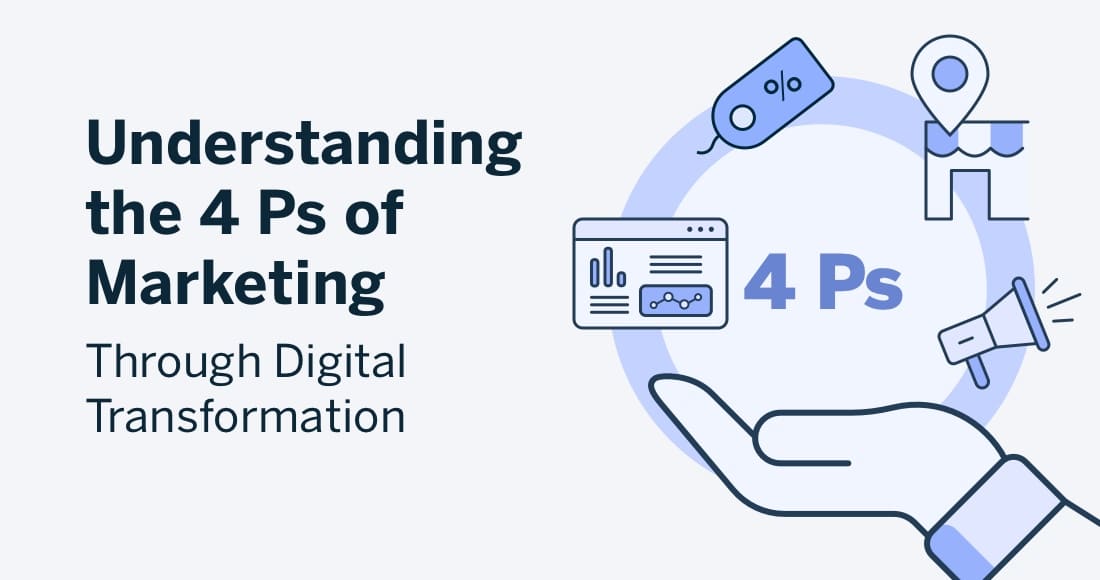The 4 Ps of marketing — product, price, place and promotion — have provided a standard framework within which marketing strategies and programs have been built for over 60 years. Jerome McCarthy first proposed the modern form of the 4 Ps in his 1960 textbook, Basic Marketing: A Managerial Approach and they are widely taught as a frame of reference for marketers to build and execute successful campaigns.
However, the evolution of the digital age has caused the standard methods and practices of nearly every industry to change and grow to work within this new paradigm, and marketing is certainly no exception.
The more powerful marketing automation tools and platforms get at integrating data and channels and enriching them with AI and predictive intelligence, the more effective marketers become at delivering campaigns that drive tangible business outcomes.
These tools and platforms give marketers an entirely new framework within which to execute the core tenets of marketing theories like the 4 Ps.
This blog bridges the gap between theory and practice by both explaining the 4 Ps of marketing, and sharing tried-and-tested tactics that elevate the 4 Ps from lofty theory into pragmatic, ROI-driving omnichannel strategies.
The 4 Ps of Marketing
The 4 Ps of marketing refer to product, price, place, and promotion. These are the key elements that must be united to effectively foster and promote a brand’s unique value, and help it stand out from the competition.
The principles remain sound, but the practice of marketing itself has changed dramatically since the 4 Ps were first outlined. As marketers have transitioned from using traditional media channels such as print, radio, and TV toward digital channels such as email, search, and social, the primary focus is to deliver the right message, to the right customer, on the right channel.
The spray-and-pray, one-size-fits-all, mass marketing of the 90s and early 2000s that clogged inboxes and annoyed customers has been replaced by a far more strategic, considered, customer-first approach.
And yet, in the midst of the exponential change marketing has undergone, the 4 Ps remain as relevant now as they were back in the 60s. But what makes the 4 Ps of marketing so important that they have withstood the test of time, including the growth of the internet age? Below we break down each P, and outline real-world tactics that bridge the gap between theory and practice.
Product
A product refers to any item that intends to satisfy the needs and wants of a customer. It can be a tangible good, such as a clothing item or piece of software, or intangible, like a service or experience (think legal services or a cruise).
To market their products effectively, marketers must have a clear concept of what their products stand for, and what differentiates them from the competition..
Some key questions that marketers should consider in order to better understand how to strategically market their products include:
- What do customers want from your product/service? Does it satisfy their needs?
- What features of your product/service work to meet your customer’s needs? Have you missed out on any features?
- How and where will the customer use it?
- How will the customers experience it?
From a tactical point of view, marketers can influence both future product design and personalized product recommendations through campaigns such as:
- Post-purchase feedback
- In-session upsell
- Post purchase cross-sell
Post-purchase feedback campaigns are an effective way to gather qualitative feedback on anything from product functionality to build quality to overall customer experience. Though this feedback is typically gathered via automated email marketing campaigns, certain Customer Engagement Platforms also allow for this data to be collected via web channels, CRM ads, and SMS.
In-session upsell campaigns aim to get buyers to spend more in a single transaction by presenting a more appealing, albeit more expensive, package or product. The classic example is super-sizing your order at your local drive-thru restaurant, but the concept works just as well in retail and e-commerce. In-session upsells are typically executed in web or mobile in-app channels by displaying a timely overlay campaign when an item is added to the cart.
Post-purchase cross-sell campaigns encourage customers to increase their spending by promoting items commonly bought by other customers who made the same purchase. Amazon does this well with their ‘Customers who bought this item also bought’ recommendations. Post-purchase upsell campaigns are typically executed in web or email channels.
Price
First comes the product, and immediately after comes a determination of its value among target audiences. Pricing strategy is an art and a science, in that it involves both market data and careful calculations, as well as skillfully balancing between pricing that is too high or too low, and understanding how skewing either way might affect a prospect or customer’s propensity to buy.
Price not only refers to the monetary value of a product, but also the time or effort the customer is willing to expend to acquire it. Determining this will be a critical factor in revenue for the brand as it will impact profit, supply, demand, and how much marketers should spend on a promotion or marketing strategy. This is why this ‘P’ is one of the most important — if a product is priced too high or too low, the product (and brand) could fail.
Some key questions that marketers need to answer include:
- What is the value of the product or service to the buyer?
- How will your price compare to competitors?
- Are there any possible established price points for the product/service in this area?
Dynamic pricing is an effective tactic used by marketers to adjust the price of a product or service in real time based on various factors such as demand, inventory levels, and competitor pricing.
To make dynamic pricing work effectively, businesses need to collect and analyze data from various sources such as customer behavior, sales history, and market trends. This data can then be used to create algorithms that will automatically adjust prices based on the criteria set by the business.
Some tactics related to dynamic pricing include:
- Offering discounts for early purchases
- Bundling products together at a discounted rate
- Price drop campaigns
Businesses can also use variable pricing models where prices increase as inventory levels decrease or offer personalized pricing based on individual customer data.
Place
Simply put, place refers to the physical or digital channels through which brands promote their products. Examples of place include:
- In-store
- Web
- Mobile
- SMS
- Digital ads
- Direct mail
- Contact center
The digital age has introduced new challenges when it comes to reaching customers.
Some key questions that marketers need to answer include:
- Where are target customers shopping?
- Are they using desktops or mobile devices?
- Are they shopping for similar products online, or in brick-and-mortar stores?
- Where are they engaging on social media?
However, rather than thinking about a single place to promote their products and services, mature brands are far more likely to take an omnichannel approach and engage with customers across multiple channels with personalized messages in real time.
A recent study published by Forrester entitled “The Omnichannel Difference: How The Most Customer-Focused Companies Deliver The Value of Omnichannel” shows that mature, customer-obsessed firms that deploy omnichannel strategies enjoyed:
Higher margins. Sixty-two percent of respondents in the study from customer-obsessed firms indicated that their company’s omnichannel strategy has yielded higher margins for them. Compare this to just 45% of respondents from non-customer obsessed firms who said the same.
Stronger customer retention and loyalty: Just more than half of respondents in this study from customer-obsessed firms (54%) compared to 46% from non-customer-obsessed firms said their company experiences better customer loyalty and improved retention from its omnichannel efforts.
Improved customer interactions: More respondents from customer-focused companies also said their firm has more productive single interactions with its customers. For example, 52% of respondents from customer obsessed companies said omnichannel programs boosted individual customer interactions and engagement compared to 46% from non-customer-obsessed companies.
Omnichannel marketing will often use a data-led, AI-driven approach to understanding complex data points such as customer behavior, preferred channels, and lifecycle stage to determine which messages to send to which customers, through which channels, at what times.
The result is a seamless, deeply personalized customer experience that has a much higher probability of driving profitability and growth.
Promotion
In the 4 Ps of marketing, promotion refers to the activities that a company undertakes to communicate and promote its products or services to its target audience.
Promotion is the area that has arguably seen the greatest growth and change as a result of the digital age. Machine learning and AI-powered marketing platforms allow marketers to promote products easier, more effectively, and with more personalization than ever before.
Some key questions that marketers need to answer include:
- How will you reach your target audience?
- Where will you send your marketing messages to your target audience?
- How does your competition promote their product? Does that influence your own promotional activity?
- When is the best time to promote?
One of the most effective means to drive successful promotional activity today is through the use of AI-powered personalization engines.
Personalization engines unify first-party data such as demographics, sales, support calls and customer behavior. This allows marketers to better understand each customer and build rich customer profiles, and it enables brands to engage customers with relevant content in the moments that matter most.
Examples of effective personalization tactics include:
Personalized emails: Sending personalized emails to customers can increase open rates and click-through rates. This can be achieved by addressing the recipient by name, using their past purchase history or browsing behavior to suggest products they might like, and tailoring the content of the email to their interests.
Dynamic website content: Using data such as location, browsing history, and past purchases to personalize website content can improve user experience and increase engagement. For example, displaying personalized overlays, embedded content or ribbons on your brand’s website that feature recommended products or show local events or promotions based on the user’s location.
CRM ads: CRM Ads allow marketers to match CRM contacts with their profiles on networks such as Facebook and Google in order to create custom audience segments. When using a more sophisticated customer engagement platform, these segments can be created dynamically based on customer behavior and updated in real time.
Final Thoughts
It’s an exciting time to be a marketer. The wealth of tools and platforms we have at our disposal have helped us better understand our customers and enabled us to connect those customers and prospects with products and services that improve the quality of their lives.
However, the success of the campaigns we execute is still firmly grounded in the core principles of marketing: product, price, place and promotion. Successful marketers are able to marry these principles with tactics such as the ones mentioned above to deliver the predictable, profitable outcomes that their businesses demand.
The Emarsys customer engagement platform can help execute these kinds of campaigns, and drive personalized omnichannel marketing that delivers business results. It does this by unifying data and channels, personalizing cross-channel experiences, and automating customer journeys at scale.












